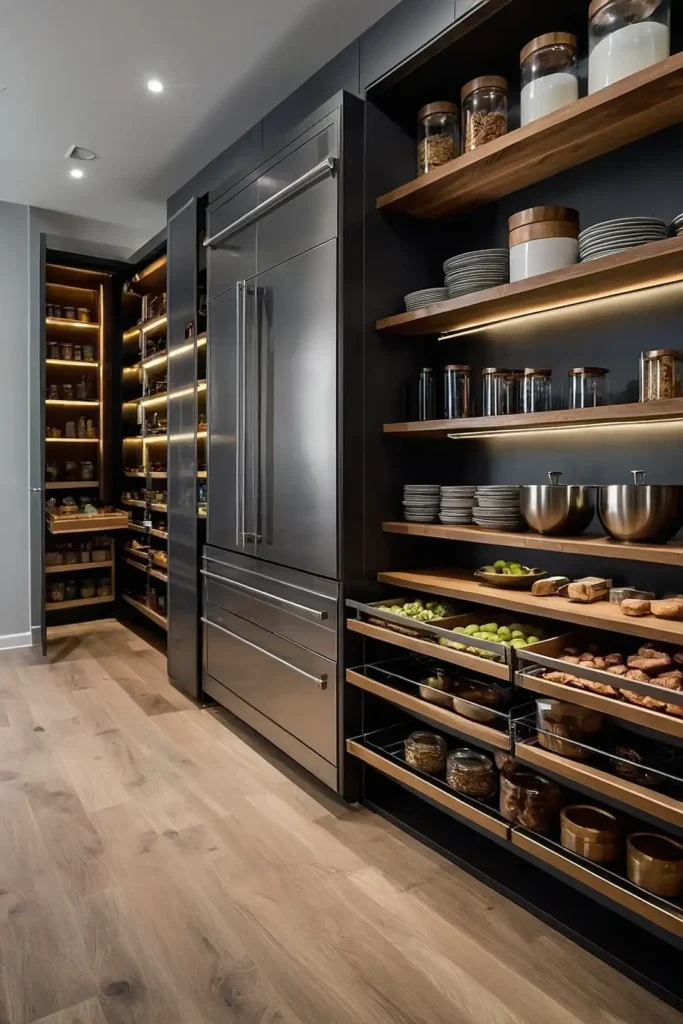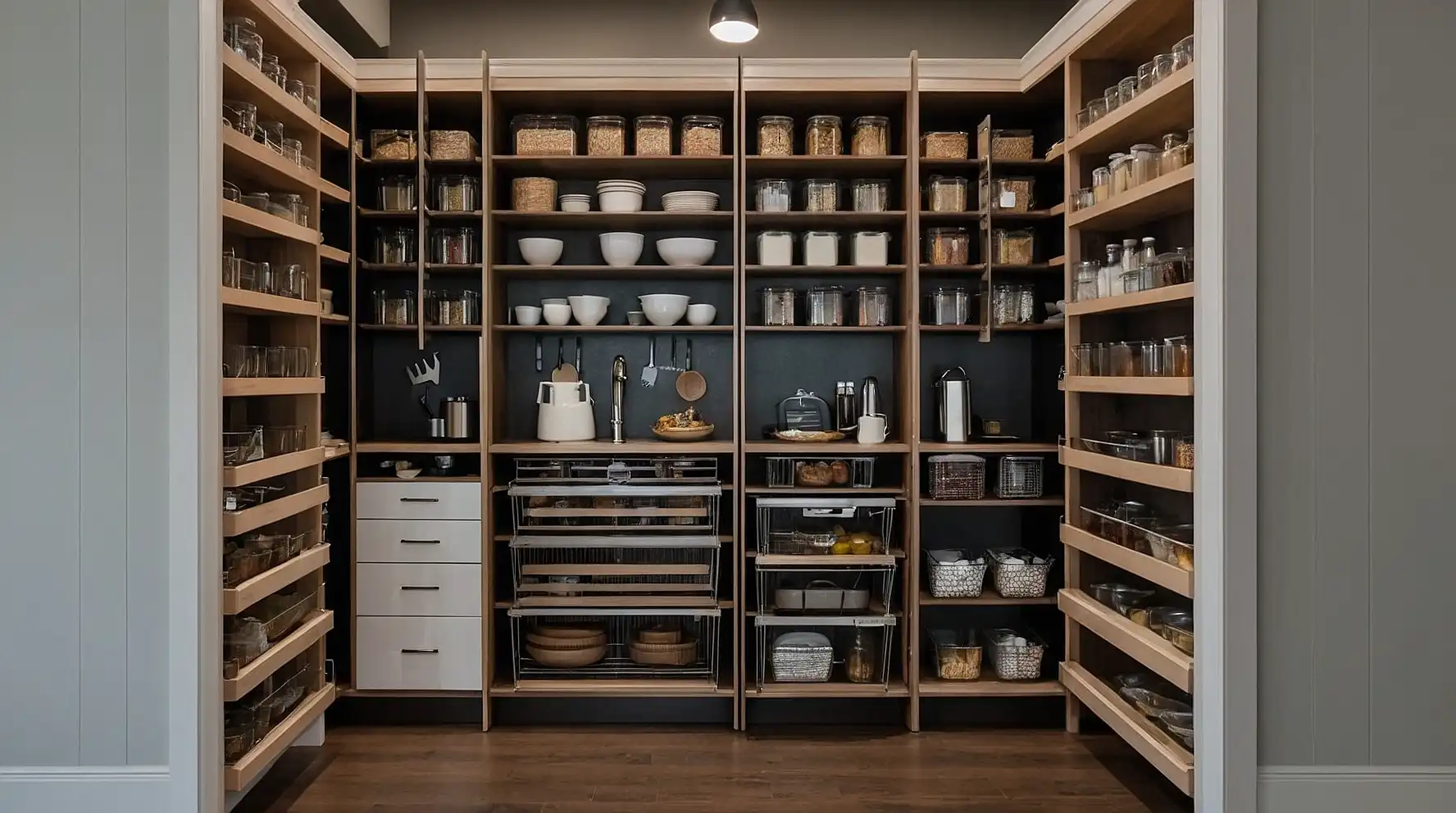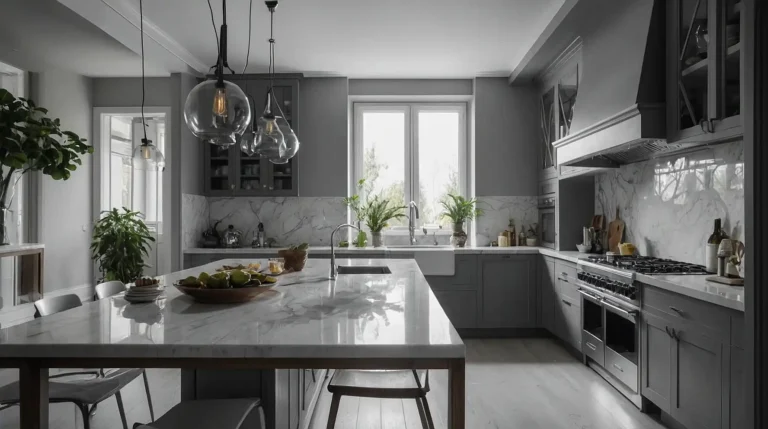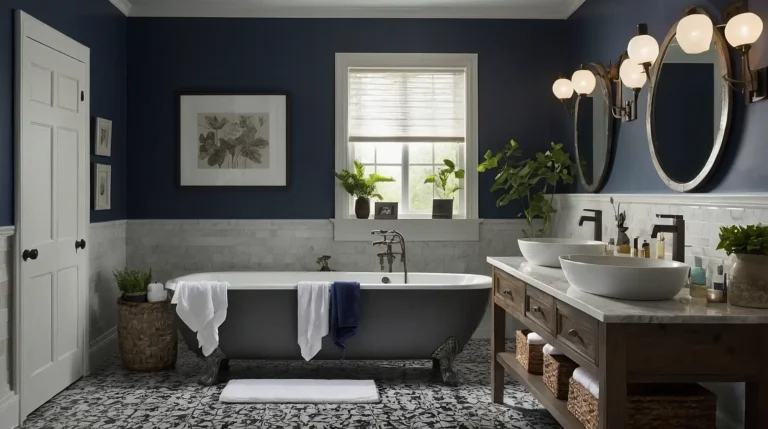27 Brilliant Walk-in Pantry Ideas to Maximize Your Kitchen Storage
A well-designed walk-in pantry transforms your kitchen experience, offering abundant storage that keeps essentials organized and accessible.
This dedicated space eliminates countertop clutter and streamlines meal preparation.
Today’s pantry designs blend functionality with style, turning a utilitarian space into a feature that enhances your home’s value.
Even modest-sized pantries can work wonders with the right organization system.
Discover these 27 innovative walk-in pantry ideas to create a storage solution that perfectly suits your cooking style, space constraints, and aesthetic preferences.
1: Floor-to-Ceiling Adjustable Shelving

Maximize every vertical inch with shelving that extends from floor to ceiling. Adjustable shelves allow you to customize heights for items of various sizes.
Install thinner shelves near the top for lightweight, rarely used items. Keep everyday essentials at eye level for easy access.
Consider slide-out versions for deep shelves to prevent items from hiding in the back.
2: Dedicated Appliance Zone

Create a special section for small appliances you don’t need on your kitchen counters. Include outlets directly in this zone for convenience.
Position this area at counter height for easy use without moving appliances. This solution frees up valuable kitchen workspace while keeping tools accessible.
Label each appliance spot to maintain organization when multiple family members use the kitchen.
3: Clear Container System

Transfer dry goods like flour, sugar, pasta, and grains into matching clear containers.
This approach creates visual calm while allowing you to see inventory levels at a glance.
Choose square or rectangular containers that maximize shelf space. Add custom labels for a cohesive, organized look.
Invest in airtight options with easy-open lids for items you access frequently.
4: Color-Coded Storage Zones

Designate different pantry sections by color for intuitive organization.
Assign baking supplies to blue bins, snacks to red containers, and breakfast items to yellow zones.
This system helps everyone in the household maintain order. The visual cues make it easier to return items to their proper places.
This approach works especially well for families with children who are learning to help themselves.
5: Pull-Out Basket System

Install sliding wire or woven baskets instead of traditional shelves for flexible storage.
These baskets allow you to pull the entire contents forward for easy access.
Group similar items in each basket for logical organization. The open design provides excellent visibility while preventing items from getting lost.
Label the front of each basket for quick identification of contents.
6: Hanging Door Storage

Utilize the back of your pantry door with an over-door organizer or installed racks.
This otherwise wasted space becomes perfect for spices, oils, or small packaged items.
Choose adjustable systems that can accommodate various product sizes. Keep frequently used items here for grab-and-go convenience.
Ensure your selections have secure anchoring to prevent shifting when the door opens and closes.
7: Built-In Wine Storage

Incorporate diagonal cubbies or a wine rack system within your pantry design. This dedicated space protects bottles while keeping them properly positioned.
Position wine storage away from heat sources and at the proper angle. Add stemware holders nearby to create a complete beverage station.
This solution works well for both everyday bottles and special occasion selections.
8: Pantry Inventory System

Install a small whiteboard or chalkboard inside your pantry for tracking inventory. Update it whenever you use the last of something or notice supplies running low.
This simple system prevents over-buying or forgetting essential items. Take a quick photo of your list before grocery shopping trips.
Digital alternatives include pantry inventory apps that the whole family can access.
9: Custom Spice Storage Solution

Create a dedicated spice organization system with stepped shelves or a pull-out rack.
Uniform jars with clear labels transform chaotic spice collections into a functional display.
Arrange alphabetically or by cuisine type for easy location. Keep everyday spices at eye level and seasonal or specialty spices higher up.
Consider magnetic options for wall space or dedicated drawers for maximum visibility.
10: Beverage Station Organization

Designate a specific zone for drinks and drink-making supplies. Include storage for coffee, tea, cocoa, and mixers along with associated equipment.
Install a small countertop area for drink preparation if space allows. Add a mini-fridge for cold beverages if your pantry can accommodate it.
This centralized approach keeps beverages from taking over kitchen cabinet space.
11: Lazy Susan Corner Solutions

Maximize awkward corner spaces with rotating Lazy Susan shelving units.
These clever installations provide access to every item without reaching into deep corners.
Choose double-decker versions for maximum storage capacity. Use these for items of similar height to prevent toppling when rotating.
This solution eliminates the frustration of inaccessible “dead space” in corner configurations.
12: Labeled Basket System for Produce

Allocate ventilated baskets for onions, potatoes, and other non-refrigerated produce.
The airflow prevents premature spoilage while keeping these items organized.
Position these baskets away from heat sources for maximum freshness. Label each basket clearly to maintain organization.
This approach reduces refrigerator crowding while keeping produce visible and accessible.
13: Pull-Out Baking Sheet Storage

Install vertical dividers to create slots for baking sheets, cutting boards, and serving trays.
This specialized storage keeps these awkward items neatly upright and easily accessible.
Position this near your baking supply zone for logistic efficiency. Adjust divider spacing to accommodate your specific collection.
This organization prevents the frustrating avalanche of stacked pans that occurs in traditional storage methods.
14: Glass Jar Bulk Storage Display

Create an attractive and functional display of bulk ingredients in matching glass jars.
Items like pasta, beans, and rice become visual features rather than cluttered storage.
Install proper lighting to highlight this area as a design element. Add scoops or measuring cups for each container to simplify cooking prep.
This approach combines beautiful presentation with practical storage for everyday cooking essentials.
15: Dedicated Kids’ Snack Zone

Designate a low shelf or basket specifically for child-approved snacks. Stock this area with parent-approved options that kids can access independently.
Use clear containers so children can see available choices. Position this zone at a height appropriate for your children’s ages.
This system promotes independence while keeping less nutritious options organized and portion-controlled.
16: Rolling Library Ladder

Install a sliding ladder system to safely access high shelves in tall pantries. This practical addition adds architectural interest while maximizing vertical storage.
Choose a ladder with locking wheels for safety and stability. Store seldom-used seasonal items or bulk purchases on the highest shelves.
This feature transforms ordinary pantries into statement spaces with distinctive character.
17: Hidden Countertop Workspace

Include a fold-down or pull-out counter surface within your pantry design. This clever feature provides additional prep space that disappears when not needed.
Position this near your appliance zone for functional workflow. Install under-counter lighting to illuminate this workspace properly.
This solution proves invaluable during holiday cooking or entertaining when extra surfaces are needed.
18: Vacuum Sealed Storage System

Incorporate space for a vacuum sealer and associated storage containers. This modernizes your bulk storage approach for maximum freshness.
Create a dedicated zone for sealed packages with clear labeling. Include markers and labels nearby for easy identification.
This system extends the shelf life of pantry staples and reduces food waste significantly.
19: Custom Drawer Inserts

Replace standard shelving with deep drawers featuring custom dividers.
This approach prevents small packages from getting lost while maximizing organizational control.
Design different drawer configurations based on contents. Keep similar items grouped together for intuitive meal preparation.
Full-extension hardware ensures you can see everything in each drawer without straining.
20: Chalkboard or Whiteboard Walls

Paint one wall with chalkboard or whiteboard paint for meal planning and lists. This interactive surface becomes both functional and decorative.
Use this space for weekly menus, needed ingredients, or favorite recipes. Add magnetic functionality if possible for even more versatility.
This practical addition eliminates paper clutter while keeping important information visible.
21: Pantry Lighting Strategy

Install motion-sensor lighting that activates when you enter the space. Supplement with under-shelf lighting to eliminate dark corners on lower shelves.
Choose LED options for energy efficiency and reduced heat output. Consider dimmable features if your pantry serves multiple functions.
Proper lighting transforms your pantry experience, helping you find items quickly and making the space more inviting.
22: Glass-Front Refrigerator Integration

Incorporate a compact glass-door refrigerator into your pantry design.
This addition creates an all-in-one food storage solution that keeps refrigerated items visible.
Position refrigeration near the pantry entrance for convenience. Use this for overflow refrigeration during parties or holiday cooking.
The glass front encourages inventory awareness while adding a professional touch to your pantry design.
23: Shopping Bag Storage Solution

Create a dedicated zone for reusable shopping bags, ensuring they’re always ready for grocery trips.
A simple wall-mounted system keeps bags accessible but not underfoot.
Position this near the pantry entrance for grab-and-go convenience. Choose a design that allows bags to be inserted and removed individually.
This thoughtful addition supports eco-friendly shopping habits while eliminating the “bag of bags” clutter problem.
24: Pet Food Station

Designate space for pet supplies with sealed containers for food and bins for treats and toys.
This centralized approach keeps pet essentials organized and fresh.
Include a scoop with each container for easy measuring. Position this zone near the floor for convenient access during feeding time.
This system prevents pet supplies from cluttering your kitchen cabinets or creating eyesores in living areas.
25: Seasonal Rotation System

Design your pantry with designated “seasonal zones” for holiday baking supplies or special occasion ingredients. These areas can shift purpose throughout the year.
Use clearly labeled containers that stack efficiently when not in use. Implement a twice-yearly rotation schedule to keep everything fresh and organized.
This approach ensures specialty items remain accessible when needed without cluttering prime pantry real estate year-round.
26: Recipe Binder Station

Create a small storage area for cookbooks and recipe binders within your pantry. Keep favorite family recipes close to where you’ll gather ingredients.
Install a small shelf or wall pocket specifically for these resources. Add a clipboard or tablet holder for digital recipes.
This thoughtful addition streamlines meal preparation and preserves cherished family cooking traditions.
27: Vertical Hanging Storage

Utilize wall space between shelves with hanging storage for lightweight items.
S-hooks, pegboards, or rail systems create flexible storage for tools and packaged goods.
Position these systems at eye level for maximum convenience. Choose adjustable options that can evolve as your storage needs change.
This approach activates otherwise wasted space while keeping frequently used items highly visible and accessible.
Conclusion
Start with systems that address your biggest organization challenges. Implement changes gradually, refining as you discover what works best for your cooking style.
Remember that the perfect pantry combines both functional efficiency and personal aesthetic preferences.







